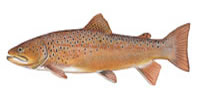Freshwater Fish - Species
Species Specific Regulations
Brown trout
Freshwater Fishing License required.
Brown trout (Salmo trutta)
Description: (Anatomy of a Fish)
The brown trout's body coloration in South Carolina varies between wild and hatchery-reared fish. The wild brown trout’s body coloration is typically dark olive with brilliant yellow and large black spots. The olive background generally extends down the sides of the fish with brilliant red spots on sky-blue halos. The body color fades from olive to a richly colored yellow belly. The anal fin of wild brown trout often exhibits a white leading edge with a black outline (much like brook trout) but this pattern is absent on the other fins along the belly. Wild brown trout often have black spots present on the head and upper side of the body, including the dorsal fin. Red spots also occur also along the sides and are sometimes present in the dorsal and adipose fins. Black spots are found on the dorsal and adipose fins, but not the caudal. The edge of the anal fin is white.
Range: Mountain streams of Oconee, Pickens and Greenville counties. Also present in Lake Jocassee and the tailraces of lakes Murray and Hartwell.
Average Length: 8-10 inches
Average Size: 4-8 ounces in streams to several pounds in Lake Jocassee and lakes Hartwell and Murray tailraces.
South Carolina State Record: 17 pounds 9.5 ounces (1987)
Life Expectancy: Approximately 18 years (southern populations 7-10 years)
Preferred Habitat
Brown trout can tolerate warmer water temperatures (not exceeding 68 degrees Fahrenheit for any extended period) than the brook and rainbow trout. Brown trout can be found in small creeks, rivers and reservoirs. They inhabit the deeper pools and undercut banks of these habitat types seeking out areas of low light intensity. Brown trout are better competitors than rainbow and brook trout in larger streams with multiple species.
Food Habits
-
Aquatic and terrestrial insects, crayfish and fish.
Spawning
- Brown trout spawn from October through November when the females deposit 600-3,000 eggs into a shallow nest called a redd.
Miscellaneous
The brown trout is not native to the United States but comes from Europe. Since their introduction to North America in 1883, the brown trout has been stocked into the waters of every continent except Antartica. This trout is more tolerant of warmer and turbid water than either the rainbow or the brook trout allowing it to have a greater habitat range. The brown trout inhabiting deeper, darker waters and undercut banks adds to the challenge anglers face when fishing for this exceptional fish.
Commonly Mistaken Species
Some species of fish that are commonly mistaken for this species:
Literature Cited
Rohde, Fred C, Arndt, Rudolf G., Foltz, Jeffery W., Quattro, Joseph M. 2009. Freshwater Fishes of South Carolina. University of South Carolina Press, Columbia, South Carolina.
Wildlife and Freshwater Fisheries Division. 2009. South Carolina Guide to Freshwater Fishes.
Fish Illustration by Duane Raver.


